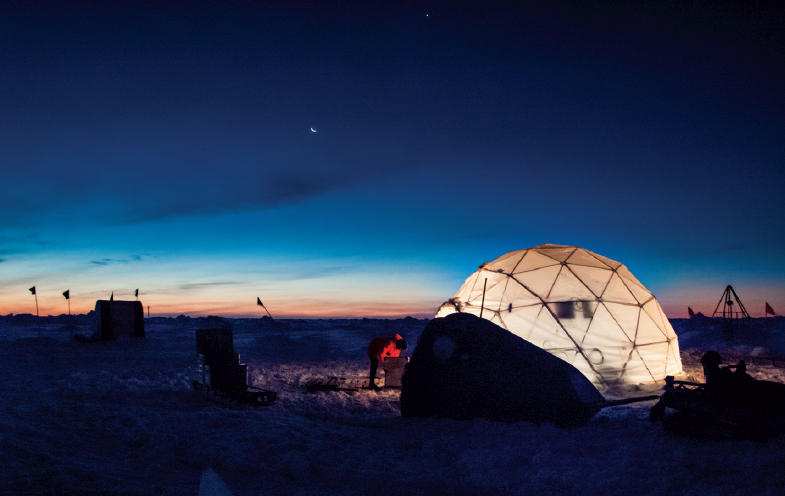Endnotes
1Mid-Term Assessment of Progress on the 2015 Strategic Vision for Antarctic and Southern Ocean Research (2021), A Strategic Vision for NSF Investments in Antarctic and Southern Ocean Research (2015), Future Science Opportunities in Antarctica and the Southern Ocean (2011).
2 Wehl, P. M., et al. 2021. A short scan of Māori journeys to Antarctica. Journal of the Royal Society of New Zealand.
3 International Association of Antarctica Tour Operators. 2020. IAATO Antarctic Visitor Figures 2019–2020.
4 For a short overview of the science of climate change, see Climate Change: Evidence and Causes: Update 2020. The National Academies Press.
5 When land-based ice such as the Antarctic ice sheet melts, this adds new water to the world’s oceans and thus raises sea level. In contrast, melting of sea ice does not cause sea level rise, just as a melting ice cube in a glass of water does not raise the water level in a glass.
6 Pollard, D., and R. M. DeConto. 2009. Modelling West Antarctic ice sheet growth and collapse through the past five million years. Nature 458:329–332.
7 Naish, T., et al. 2009. Obliquity-paced Pliocene West Antarctic ice sheet oscillations. Nature 458:322–328.
8 Klages, J. P., et al. 2020. Temperate rainforests near the South Pole during peak Cretaceous warmth. Nature 580:81–86.
9 WAIS Divide Project Members. 2015. Precise interpolar phasing of abrupt climate change during the last ice age. Nature 520:661–665.
10 Corsolini, S., et al. 2019. Persistent Organic Pollutants in Antarctica. Antarctic Environments Portal.
11 Waller, C. L., et al. 2018. Microplastics in the Southern Ocean. Antarctic Environments Portal.
12 For more information about the general issue of plastics pollution in the world’s oceans, see Reckoning with the U.S. Role in Global Ocean Plastic Waste. The National Academies Press.
13 National Science Foundation. 2014. Antarctic seals may use Earth’s magnetic field to navigate while hunting.
14 Hughes, K. A., et al. 2020. Invasive non-native species likely to threaten biodiversity and ecosystems in the Antarctic Peninsula region. Global Change Biology 26(4):2702–2716.
15 Lee, J. R., et al. 2017. Climate change drives expansion of Antarctic ice-free habitat. Nature 547:49–54.
16 Smith, K. E., et al. 2017. Climate change and the threat of novel marine predators in Antarctica. Ecosphere 8(11):e02017.
17 Hartinger, M. D., C. R. Clauer, and Z. Xu. 2016. Space weather from a southern point of view. Eos 97.
18 U.S. Antarctic Program. The USAP Portal: Science and Support in Antarctica.
19 National Science Foundation. Antarctic Conservation Act and Permits.
20 See IRIS, UNAVCO, PGC, and IDP.
21 U.S. Coast Guard Acquisition Directorate. Polar Security Cutter.
22 Future USAP. 2021. New Antarctic Research Vessel.
23 See NSF Classroom Resources: Arctic and Antarctic and USAP/NSF Educational Tools.
24 For example, see ITGC Education, IceCube Neutrino Observatory Educational Programs, and Penguin Science Classroom Activities.
25 The Antarctic Treaty. Antarctic Treaty (ats.aq).
26 See the Scientific Committee on Antarctic Research.
27 See the Polar Research Board.
28 See the Council of Managers of National Antarctic Programs.
29 See G-Science Academies Statement 2020: Basic Research.
30 See ITGC.
31 Somero, G. N. 2010. The physiology of climate change: How potentials for acclimatization and genetic adaptation will determine “winners” and “losers.” Journal of Experimental Biology 213(6):912–920.
32 See McMurdo Dry Valleys Long Term Ecological Research.
33 Mikucki, J. A., et al. 2015. Deep groundwater and potential subsurface habitats beneath an Antarctic dry valley. Nature Communications 6:6831.
34 See IceCube Neutrino Observatory.
35 See the Southern Ocean Carbon and Climate Observations and Modeling project.
36 See the Polar Earth Observing Network.
37 See Landsat Image Mosaic of Antarctica.
38 See ITS_LIVE.
39 See Reference Elevation Model of Antarctica.
40 Smith, B., et al. 2020. Pervasive ice sheet mass loss reflects competing ocean and atmosphere processes. Science 368(6496):1239–1242.
41 See Ice Sheet Modeling Group: BedMachine Antarctica v1; SVS: BedMachine: A high-precision map of Antarctic ice sheet bed topography (nasa.gov).

A special thanks for the insights and assistance provided by the following individuals: Anne Johnson, Science Writer; Amy Barger, University of Wisconsin; Bob Clauer, Virginia Tech; Dan Costa, University of California, Santa Cruz; Indrani Das, Columbia University; Bill Deitrict, Northeastern University; Mike Goosef, University of Colorado Boulder; Mark Halpern, University of British Columbia; Deneb Karentz, The Ohio State University; Berry Lyons, The Ohio State University; Ted Scambos, University of Colorado Boulder; Lynne Talley, Scripps Institution of Oceanography; Terry Wilson, University of San Francisco; Eric Wolff, University of Cambridge; and representatives of the NSF Office of Polar Programs.
This booklet provides a brief overview of why the U.S. government has stood for decades as the global leader in Antarctic research—and why that investment remains vital to U.S. interests today. We offer it as a resource to policy makers, educators, and all people who are interested in the nation’s role in Antarctica. Find out what makes Antarctica such a uniquely valuable place for investigating our planet and the Universe beyond. Learn what it is like to work in the icy wilderness and how the quest for knowledge links people across borders. Explore how the insights gleaned in this remarkable continent ultimately enrich all of our lives—and why Antarctica matters for our shared future.



